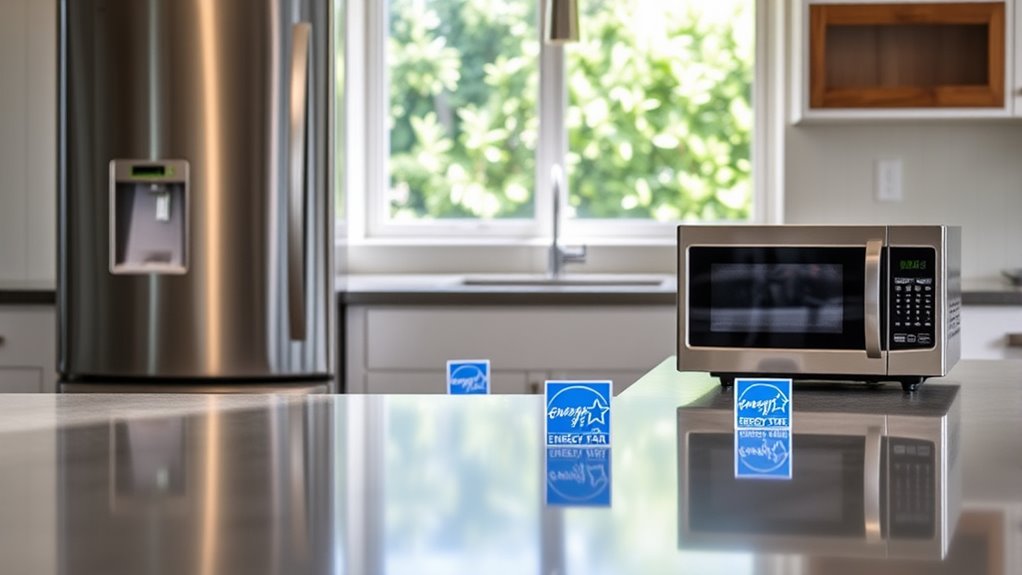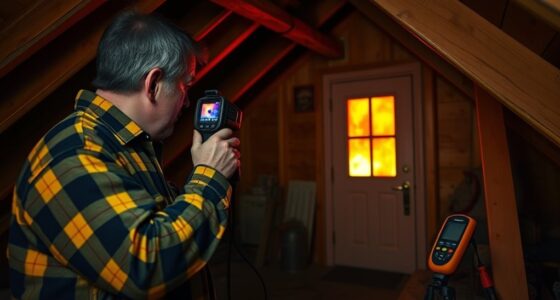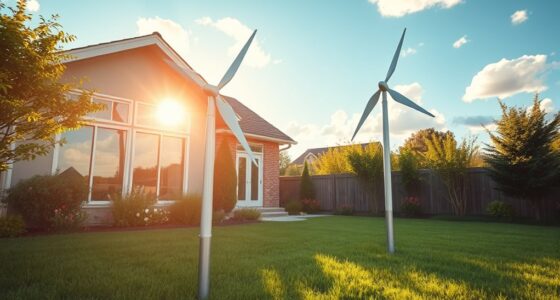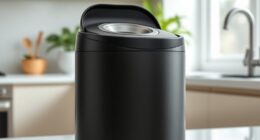Energy Star ratings help you identify appliances that are more energy-efficient than standard models, saving you money on utility bills and reducing environmental impact. Look for the blue ENERGY STAR label, which indicates the appliance meets strict energy-saving criteria set by EPA and DOE. The EnergyGuide label also shows estimated annual energy use and costs, making comparisons easier. Keep exploring to discover how to choose the best energy-efficient appliances for your needs.
Key Takeaways
- ENERGY STAR labels indicate appliances that exceed federal efficiency standards, helping consumers identify more energy-efficient options.
- The blue ENERGY STAR logo signifies high-performance appliances, while EnergyGuide labels provide estimated energy costs and usage.
- ENERGY STAR-certified appliances are typically 10-15% more efficient than minimum standards, leading to cost savings.
- Products meeting higher efficiency tiers, like CEE Tier 1 or Most Efficient, offer even greater energy savings.
- Choosing ENERGY STAR appliances reduces energy bills, environmental impact, and supports sustainable innovation.

Are you looking to save money and reduce your environmental impact? Understanding Energy Star ratings for appliances can help you do just that. The ENERGY STAR program is a partnership between the EPA and the DOE that identifies appliances exceeding federal energy efficiency standards. When you see the ENERGY STAR label, it means that the appliance uses less energy to perform the same task as a standard model, making it a smart choice for both your wallet and the planet.
Save money and help the environment with ENERGY STAR appliances that use less energy for the same performance.
The program covers a variety of appliances, including refrigerators, freezers, dehumidifiers, and more. For example, ENERGY STAR-certified refrigerators are about 15% more efficient than the federal minimum standards. This efficiency translates into lower energy consumption—often less than a 60-watt light bulb running continuously. Freezers and dehumidifiers that meet ENERGY STAR standards also consume less energy, typically around 10% and 15% less, respectively, than comparable non-certified models. These savings can add up over time, helping you cut your utility bills considerably.
When you’re shopping, it’s helpful to understand the difference between the ENERGY STAR label and the EnergyGuide label. The ENERGY STAR label is a blue star icon indicating the product surpasses high-efficiency thresholds, while the EnergyGuide label provides an estimated annual energy use and operating costs. The EnergyGuide includes an energy scale for comparing similar products, giving you a clearer picture of which appliance is more economical to run. Remember, you shouldn’t confuse the yellow EnergyGuide label with the ENERGY STAR certification, as they serve different purposes.
Beyond individual appliances, the program promotes energy-efficient commercial buildings and new homes. It also works with the Consortium of Energy Efficiency (CEE), which offers voluntary tiers of efficiency that go beyond ENERGY STAR standards. A product meeting CEE Tier 1 standards already qualifies for ENERGY STAR, and higher CEE tiers indicate even greater efficiency. Appliances rated highly by both ENERGY STAR and CEE are among the most efficient options available, often recognized as “Most Efficient,” ensuring you’re selecting top-performing models.
Choosing ENERGY STAR appliances not only saves you money through lower energy bills but can also qualify you for tax credits or incentives. By switching to certified products, you contribute to reducing household carbon footprints and supporting sustainable innovation. To identify these appliances, look for the blue ENERGY STAR logo on the product or use online tools to compare models by efficiency. For the most advanced savings, consider appliances featured in the ENERGY STAR Most Efficient program. Always review the EnergyGuide label to understand the estimated annual energy use and costs, helping you make informed decisions. Meeting ENERGY STAR standards guarantees you’re selecting quality, energy-efficient appliances that benefit both your household and the environment. Additionally, understanding the contrast ratio of a projector can help you choose models that deliver better picture quality in dark viewing environments.
Frequently Asked Questions
How Often Are Energy Star Ratings Updated?
You wonder how often Energy Star ratings get updated. These updates happen periodically to reflect technological advances and new energy efficiency standards. Manufacturers must meet strict criteria to earn certification, which is reviewed regularly. Updates can substantially improve appliance efficiency, sometimes reducing energy consumption by up to 85%. Staying informed about these updates helps you choose the most energy-efficient appliances, saving you money and reducing environmental impact.
Do All Appliance Brands Carry Energy Star Labels?
You might wonder if all appliance brands carry Energy Star labels. Not all brands participate, especially smaller or local ones that might not meet the standards or choose not to pursue certification. Major brands like Samsung, LG, and Whirlpool often offer Energy Star certified models, making it easier for you to find efficient options. Keep in mind, some brands focus on other eco-friendly certifications or standards instead.
How Do Energy Star Ratings Impact Long-Term Savings?
You might think that snagging a fancy, energy-efficient appliance would break the bank, but surprisingly, those ENERGY STAR ratings boost your long-term savings. By using less energy, you’ll see lower utility bills, sometimes saving hundreds over years. Plus, you avoid costly repairs with smarter, more durable appliances. So, in the end, little investments now pay off big time, making your wallet—and the planet—happier in the long run.
Are Energy Star Appliances Environmentally Friendly Beyond Energy Savings?
You’re asking if Energy Star appliances are environmentally friendly beyond just saving energy. The answer is yes. These appliances reduce greenhouse gas emissions, improve air quality by lowering pollutants, and help decrease fossil fuel dependence. They also promote innovation and market shifts toward greener products. By choosing Energy Star, you’re supporting a cleaner environment, reducing your carbon footprint, and contributing to broader efforts to protect our planet for future generations.
Can Older Appliances Be Upgraded to Meet Energy Star Standards?
Like Daedalus trying to craft wings, you wonder if older appliances can be upgraded to meet Energy Star standards. Unfortunately, retrofitting is often like patching a sinking ship—costly and ineffective. Most parts can’t be upgraded enough to reach the strict efficiency levels, and partial improvements rarely qualify. Instead, you’d be better off replacing old units with new, certified appliances that already meet those high standards, ensuring better energy savings and performance.
Conclusion
By choosing Energy Star-rated appliances, you can save up to 30% on energy bills and help protect the environment. Did you know that if everyone in the U.S. switched to Energy Star appliances, we could prevent over 4 billion tons of greenhouse gases annually? That’s like taking millions of cars off the road! So, next time you shop for appliances, remember the rating—it’s a simple step that makes a big difference for your wallet and the planet.










